Intro
The Cheval du Vercors de Barraquand or Barraquand Vercors Horse is a rustic horse which comes from the Vercors mountains and is known to be particularly surefooted.
Origins
Originally recorded at the Abbey of Léoncel, by Dom Perrier in 1760, this is an old bloodline. During the 18th century transporting goods for trade was not easy on mountain paths, making tradesmen dependent on pack animals to follow their routes. By early 20th century horses had replaced donkeys and mules for this purpose. Those bred in the mountains were particularly popular and Barraquand Vercors numbers began to grow. By the end of the 19th century breeders began switching to breed heavier horses and cows. These bigger animals began to deplete the mountain pastures too fast, so farmers began migrating out of the mountains into the plains.
Among the farmers was a Mr. Barraquand, who refused to leave his land in Ambel, believing that these robust and frugal mountain animals should be preserved. An old man, he handed the torch to his son Jules, who at 14 acquired six mares and stallions to be the herd nucleus. His breeding methods proved to be sound and by the early 20th century he had nearly 200 broodmares and around 8 stallions. He had also homogenized the breed, creating a well-defined type. Obviously his efforts were rewarded, as the horse is named after this special family.
As with many European breeds, the wars took their toll. WWI stopped breeding, although it resumed as soon as peace was proclaimed. Not only did the Barraquand family start breeding again immediately, they bought an entire mountain (about 800 hectares) to facilitate their plans. WWII was far worse for the breed, as the Barraquand family farm was destroyed by the Germans. Their animals killed, let go or taken for military use.
The Rebuild
It was Frédéric Barraquand who began to painstakingly rebuild the estate and breeding program in Arles. He found and collected about 150 animals that met Vercors standards and again began to breed them. Not long after he got started, automobiles began to make an appearance and by mid 19th century he threw in the towel and dissolved his herd in 1963.
However, the Barraquand family is demonstrably stubborn and Jean Louis Barraquand (Jules’ grandson) began another program in 1994, using three mares and a stallion. Again, the family breeding practices were sound and by 1997 their herd had grown to 51. Today the Barraquand celebrated as a regional heritage and the only breed specific to the Rhône Alpes region. According to the last DAD-IS numbers they are critical maintained and as of 2021 there were 200 of them.
Features
Average height 14.2-15.3 hands
Mane and tail hair is thick and wavy
Extremely surefooted
Physique
Head has a straight profile and broad forehead
Ears are small and crescent shaped
Neck is muscular with a well developed crest
Chest is deep
Back is short and wide
Hindquarters are powerful
Legs are strong with well defined joints
Hooves are small and solid
Traditional Colors
Almost always bay or brown, sometimes mealy
Face white markings are discouraged and only accepted if they do not go lower than their eyes. Leg markings should be black.
Temperament
Undemanding and sober
Easy going and kind
Use
Agriculture
Logging
Forestry work
Ski jöering
Helpful Links
*All links open in a new window
Vercors de Barraquand, Association nationale Cheval du Vercors de Barraquand (ANCVB)
